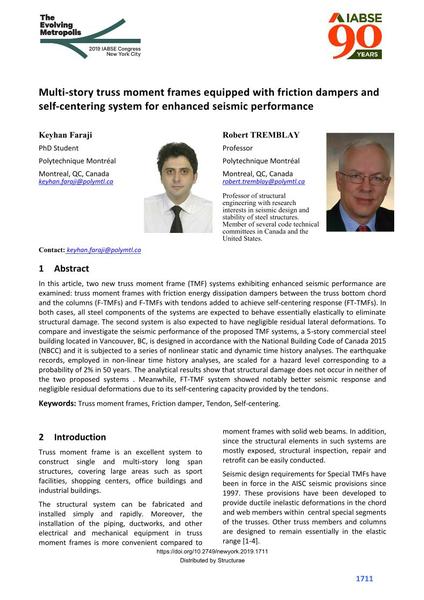Multi-story truss moment frames equipped with friction dampers and self-centering system for enhanced seismic performance

|
|
|||||||||||
Bibliografische Angaben
| Autor(en): |
Keyhan Faraji
(Polytechnique Montréal )
Robert Tremblay (Polytechnique Montréal) |
||||
|---|---|---|---|---|---|
| Medium: | Tagungsbeitrag | ||||
| Sprache(n): | Englisch | ||||
| Tagung: | IABSE Congress: The Evolving Metropolis, New York, NY, USA, 4-6 September 2019 | ||||
| Veröffentlicht in: | The Evolving Metropolis | ||||
|
|||||
| Seite(n): | 1711-1718 | ||||
| Anzahl der Seiten (im PDF): | 8 | ||||
| DOI: | 10.2749/newyork.2019.1711 | ||||
| Abstrakt: |
In this article, two new truss moment frame (TMF) systems exhibiting enhanced seismic performance are examined: truss moment frames with friction energy dissipation dampers between the truss bottom chord and the columns (F-TMFs) and F-TMFs with tendons added to achieve self-centering response (FT-TMFs). In both cases, all steel components of the systems are expected to behave essentially elastically to eliminate structural damage. The second system is also expected to have negligible residual lateral deformations. To compare and investigate the seismic performance of the proposed TMF systems, a 5-story commercial steel building located in Vancouver, BC, is designed in accordance with the National Building Code of Canada 2015 (NBCC) and it is subjected to a series of nonlinear static and dynamic time history analyses. The earthquake records, employed in non-linear time history analyses, are scaled for a hazard level corresponding to a probability of 2% in 50 years. The analytical results show that structural damage does not occur in neither of the two proposed systems . Meanwhile, FT-TMF system showed notably better seismic response and negligible residual deformations due to its self-centering capacity provided by the tendons. |
||||
| Stichwörter: |
Spannglied
|
||||
